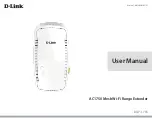
Page 46 / 107
Section 6. Operation of UMX-OPT-TX150R
6.11.
Switching the EDID
Use a screwdriver to change the memory address on the rear side of the
UMX-OPT-TX150R.
After any of the rotary switches has been rotated, the unit waits approximately 2 seconds
before the selected EDID becomes active.
The address #0 (on any rotary switches) has a special function. If a receiver is connected
to the output, then its EDID is copied to the input connector. If no receiver is connected to
the output then the EDID transmitted to the input connector is the EDID of the last
connected monitor.
Info
After every EDID change, UMX-OPT-TX150R toggles the HOT PLUG signal for approx. 1
second. Some graphic cards or DVD players do not sense the HOT PLUG signal, and
even if EDID has been changed, the set resolution is not affected. In this case the source
device must be restarted, or powered OFF and ON again.
Important!
Switching EDID is available only with rotary switches. (Switching with Lightware Matrix
Controller Software or protocol command is not available.)
6.12.
Deleting the EDID
Only user and last attached EDIDs can be deleted. Deleting means the factory EDID
(Universal HDMI or Analog EDID) will be loaded into the desired user EDID memory.
6.13.
HDCP management
The UMX-OPT-TX150R can work as a HDCP compliant device, or act as a non-HDCP
compliant sink. The HDCP capability can be disabled or enabled on the digital video input
ports (DVI-D, HDMI). This function helps to apply encryption only when it is mandatory.
Some video sources send encrypted signal when they are connected to a HDCP capable
device even if the content is not protected. This way even the unprotected content cannot
be displayed on non-HDCP displays if the signal travels through a HDCP compliant
matrix or repeater
However HDCP encryption is not required all the time (e.g. computer desktop image)
some video cards still encrypt if they detect that the sink is HDCP capable.
Avoiding unnecessary HDCP encryption
If HDCP is disabled on any digital video input port, the connected source will detect that
the sink is not HDCP capable, and turn off authentication. The source will not be able to
communicate with any of the devices (displays, repeaters, etc.) that are connected to the
receiver’s output, therefore it could not see if they are HDCP capable or not.
This forces the source to send unprotected signal only. If HDCP capability is disabled on
an input port, the connected source cannot send protected content to any display. If
HDCP function is enabled on an input port and the source sends encrypted signal, the
non-HDCP compliant devices cannot display the video.
Info:
In HDCP disable mode, protected content (i.e. Blu-ray disc) will not be displayed, thus
maintaining the rules set by the HDCP standard.
To toggle the HDCP function on the desired input port, use Matrix Controller software
(see section
9.3.3
on page
58
), use protocol command (see section
10.8.1
on page
84
),
or turn
the desired digital input’s rotary switch to address #1, and press and hold the
LEARN button for approximately 3 seconds.
+LEARN = HDCP enable / disable on DVI-D input
DVI-D
Summary of Contents for UMX-OPT-TX150R
Page 1: ...UMX OPT TX150R User s Manual ...
Page 2: ......
















































